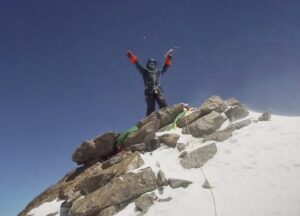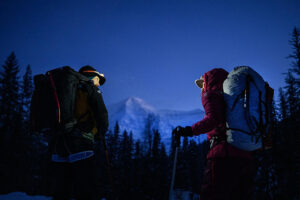Francesco Ratti, Gerome Perruquet, Alessandro Bau, and Lorenzo D’ Addario have set two new routes in the rarely visited Miyar Valley in Ladakh, India. Their routes targeted Mount Maudit and the impressive northeast face of Neverseen Tower.
As D’Addario noted, even the names of the peaks contributed to the magic of this isolated valley.
“If you know how to enter it with the right spirit, it will take you to the edge of a world we usually reach only by imagination,” D’Addario said. “And the granite was excellent.”

Neverseen Tower as seen from the glacier. Photo: F. Ratti
Finding the line
The team had Neverseen Tower in mind from the start. On setting up base camp, they seized a good weather period to approach the base of the unclimbed southeast face to check potential lines.
They then headed to nearby Grandfather Enzo Peak to acclimatize, enjoying its “easy, fun, and still unclimbed” southeast ridge, as Ratti described it. Then it was on to Neverseen Tower. Alessandro Bau described the potential line this way:
The ascent to Neverseen along the southeast face was quite a puzzle. Perhaps the most complicated thing was to decide where to climb it. During the first round of acclimatization, we scrutinized it carefully, looking for the cracks that would take us to the top. But as we rappelled down Enzo Peak, the changing light revealed other cracks that had formed from the melting snow of the summit snowfields.
We discarded the most logical line, which went up an obvious dihedral on the right side, and turned our attention to the crack systems in the center of the wall and toward the col separating Lotus Peak. These lines seemed more challenging but dry and therefore also safer from falling rocks. But as always, the mountain changed the plans.
A week of bad weather set in. When conditions improved enough to continue, they found the face encrusted with ice. Still, they decided to give it a go.
They did some pitches on the first day, then left the fixed ropes and returned to their tents for the night.

On Neverseen Tower. Photo: Francesco Ratti
Fast progress
On the following day, the team progressed quickly up the ropes and beyond, in sustained but moderate terrain over good granite. Shortly after noon, the wind picked up and temperatures dropped, but they were getting close. The team identified a good bivy spot on a ledge just two pitches below the summit ridge. They decided to keep pushing and if necessary, bivouac at that spot on the way down.
“The first pitch after the ledge had cracks clogged with ice,” Ratti wrote. “But with a little patience, I managed to work my way through them and belay from just below the summit ridge.”
The team reached the snowy summit at 2 pm. In the end, they had time to rappel down and return to the tents shortly before dark.

Route map of ‘Wind of Silence,’ the new Italian route on the previously unclimbed southeast face of Neverseen Tower. It was the fourth overall climb of the peak. Photo: Francesco Ratti
They named the route Wind of Silence, as wind and silence surrounded them during the climb. The team reports that they didn’t use bolts.
Mont Maudit
Five days later, the second climb took place. This time, the goal was unplanned. It was Mont Maudit, slightly lower than Neverseen Tower. It had been climbed before, but the team went for an unclimbed 5,400m pillar on the side facing the Tandung Glacier.

The Italian team on Mount Maudit. Photo: F. Ratti
Here is Jerome Perruquet’s account of the climb:
After a first day of climbing under light sleet and a cold wind, the second day was better. We started from the tents at the base of the wall under a beautiful starry sky. We then climbed the entire route, a total of eight pitches, finding exceptional rock. By nightfall, we found ourselves at the top. We just had time to hug each other, as the icy wind signaled that it was time to descend. We reached the tents shivering from the cold.

Route map of ‘Superthuraya,’ on Mount Maudit. Photo: F. Ratti
This time, the team did use bolts on the belays coming down, “for safety and for the use of future climbers,” they said. They named this second route Superthuraya, from the exceptional quality of the rock. Thuraya was also the brand of the team’s satellite phone, which happens to be banned in India, although the climbers didn’t know this at the time. It caused them a few problems on the way back.
‘Wind of Silence’ is 6b+, 500m, and ‘Super Thuraya’ is 6c, 500m, according to Alessandro Bau.






